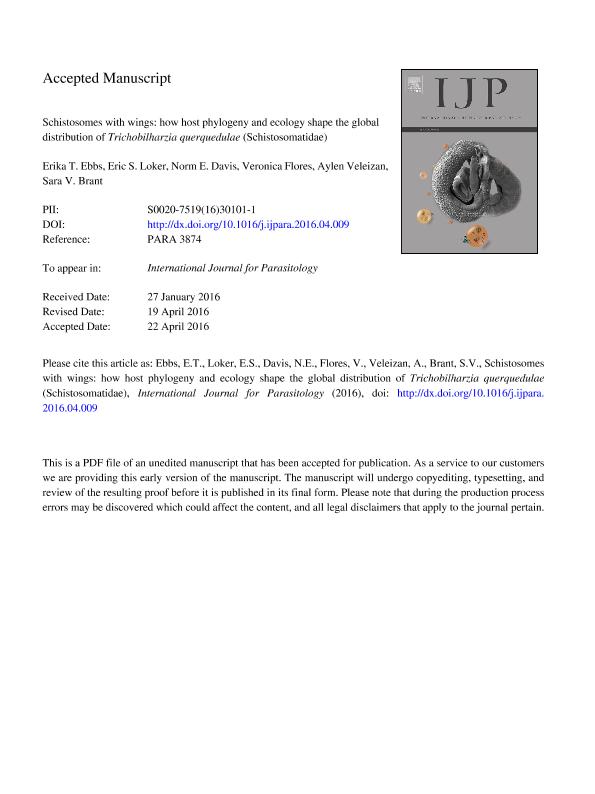Artículo
Schistosomes with wings: how host phylogeny and ecology shape the global distribution of Trichobilharzia querquedulae (Schistosomatidae)
Ebbs, Erika T.; Loker, Eric S.; Davis, Norm E.; Flores, Verónica Roxana ; Veleizán, Aylén Anabella
; Veleizán, Aylén Anabella ; Brant, Sara V.
; Brant, Sara V.
 ; Veleizán, Aylén Anabella
; Veleizán, Aylén Anabella ; Brant, Sara V.
; Brant, Sara V.
Fecha de publicación:
09/2016
Editorial:
Elsevier
Revista:
International Journal for Parasitology
ISSN:
0020-7519
Idioma:
Inglés
Tipo de recurso:
Artículo publicado
Clasificación temática:
Resumen
Migratory waterfowl play an important role in the maintenance and spread of zoonotic diseases worldwide. An example is cercarial dermatitis, caused when larval stages of schistosomes that normally develop in birds penetrate human skin. Members of the genus Trichobilharzia (Schistosomatidae), transmitted mainly by ducks, are considered to be major etiological agents of cercarial dermatitis globally. To better understand the diversity and distribution of Trichobilharzia spp., we surveyed ducks from the United States, eastern Canada, Argentina, South Africa and New Zealand. To aid in species identification of the Trichobilharzia worms recovered, regions of the Cox1, ND4 and ITS1 were sequenced. Furthermore, we provide molecular phylogenetic evidence for the cosmopolitan distribution and trans-hemispheric gene flow for one species, Trichobilharzia querquedulae, previously thought to be restricted to North America. These new samples from endemic non-migratory duck species indicate that T. querquedulae transmission occurs within each of the regions we sampled and that it is specific to the blue-winged + silver teal duck clade. Prevalence within this host group is >95% across the known range of T. querquedulae, indicating that transmission is common. Genetic divergence is evenly distributed among continents, and no phylogenetic structure associated with geography was observed. The results provide strong support for the global distribution and transmission of T. querquedulae and represent, to our knowledge, the first report of a cosmopolitan schistosome confirmed by genetic data. These data are the first known to support trans-hemispheric genetic exchange in a species responsible for causing cercarial dermatitis, indicating that the epidemiology of this group of poorly known zoonotic parasites is more complex than previously expected.
Palabras clave:
ANAS
,
CERCARIAL DERMATITIS
,
EMERGING DISEASE
,
SCHISTOSOME
,
TRICHOBILHARZIA
,
ZOONOSIS
Archivos asociados
Licencia
Identificadores
Colecciones
Articulos(INIBIOMA)
Articulos de INST. DE INVEST.EN BIODIVERSIDAD Y MEDIOAMBIENTE
Articulos de INST. DE INVEST.EN BIODIVERSIDAD Y MEDIOAMBIENTE
Citación
Ebbs, Erika T.; Loker, Eric S.; Davis, Norm E.; Flores, Verónica Roxana; Veleizán, Aylén Anabella; et al.; Schistosomes with wings: how host phylogeny and ecology shape the global distribution of Trichobilharzia querquedulae (Schistosomatidae); Elsevier; International Journal for Parasitology; 46; 10; 9-2016; 669-677
Compartir
Altmétricas



